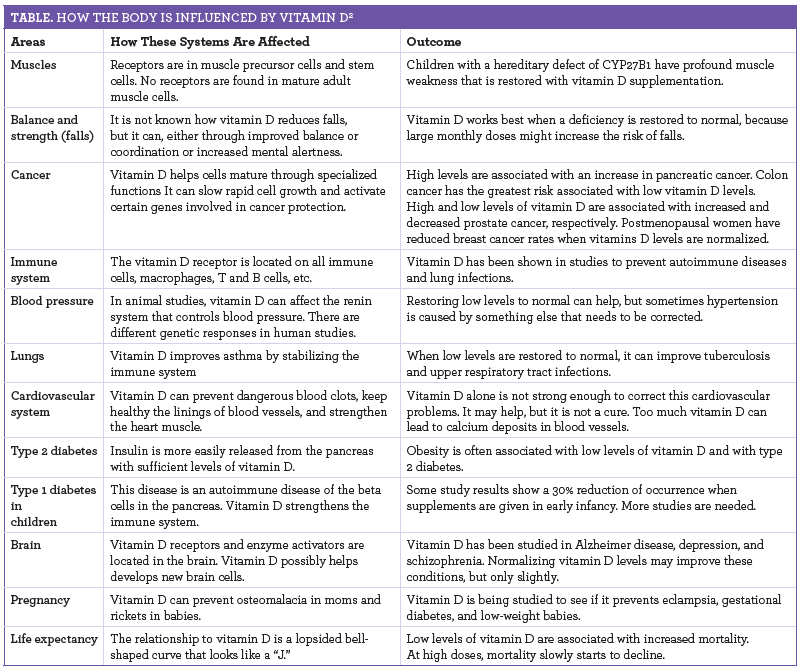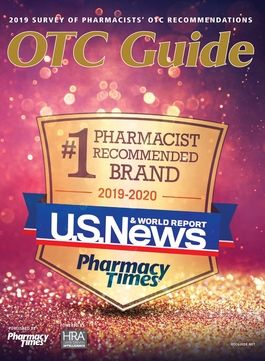Publication
Article
OTC Guide
Vitamin D Is the New Hormone
Author(s):
Vitamin D circulates in the blood and binds to receptors in order to evoke biologic action.
A vitamin is an essential nutrient that our body must obtain from food. Yet, this is not the case for vitamin D, because our bodies manufacture it.
Vitamin D, which has the chemical structure of a steroid molecule, is derived from cholesterol and is similar to the adrenal and sex hormones.1 It circulates in the blood and binds to receptors in order to evoke biologic action listed in the table.2

There are vitamin D receptors and activating enzymes throughout our bodies that perform actions. Every cell in our body has a nucleus with the ability to interact with vitamin D.2
Vitamin D is often prescribed by endocrinologists and other medical doctors as Rocaltrol (calcitriol), which is a very active form of this nutrient. There are various forms of vitamin D. It starts out as a cholesterol molecule, which we can call vitamin D1. Near the skin’s surface, it gets zapped by sunshine and becomes vitamin D2 (ergocalciferol). Then it gets transformed by activating enzymes, usually in the liver, to vitamin D3 (cholecalciferol) and by the kidneys to its most active form, vitamin D4 (Calcitriol).1
Physicians who specialize in hormones are very familiar with all the forms of vitamin D because there is a 3-way relationship with calcium, the parathyroid gland, and vitamin D. When vitamin D levels are extremely low in the body, the parathyroid gland is affected and usually tries to compensate by releasing more of the parathyroid hormone. This hormone normally deposits calcium into bone. Vitamin D causes calcium to be absorbed from the gut into the bloodstream. When vitamin D is not present, calcium is also not abundant and the parathyroid gland cannot do its job.3
Physicians also prescribe vitamin D4 when patients are not healthy enough to properly make and activate vitamin D. The D2 to D3 conversion takes place in a healthy liver, and the D3 to D4 conversion (1,25-dihydroxy-cholecalciferol) takes place in the kidneys. People in kidney failure cannot properly activate their vitamin D, so they end up with a sequelae of symptoms, including brittle bone diseases.4
It would be a mistake to assume that vitamin D is the cure for diseases and poor health, which are often the result of years of genetic mutations and/or lifestyle choices. Restoring low vitamin D levels to normal in an otherwise healthy individual can have great health benefits. But for a person who has experienced a lifetime of unhealthy choices, restoring vitamin D levels to normal may not be enough to cause a noticeable change. The underlying causes of these diseases need to be corrected for best results and a possible cure. However, symptoms can be alleviated and a disease might be improved by restoring low vitamin D levels to normal. Patients may see improvement in their energy, moods, and pain levels.
For more pharmacist OTC recommendations, visit The OTC Guide website.
Gunda Siska, PharmD, is a staff hospital pharmacist assisting doctors and nurses with drug prescribing, administration, and dispensing, as well as independently monitoring and dosing highly toxic and dangerous drugs.
REFERENCES
- Bikle D. Vitamin D: production, metabolism, and mechanisms of action. MDText.com. 2000-2017.
- Bouillon R, Marcocci C, Carmeliet G, et al. Skeletal and extra-skeletal actions of vitamin D: current evidence and outstanding questions. Endocr Rev. 2018. doi: 10.1210/er.2018-00126.
- Martins JS, Palhares MO, Teixeira OC, Gontijo Ramos M. Vitamin D Status and Its Association with Parathyroid Hormone Concentration in Brazilians. J Nutr Metab. 2017;2017:9056470. doi:10.1155/2017/9056470.
- Rocaltrol [prescribing information]. Roche Laboratories, Inc; Nutley, NJ: 1998. accessdata.fda.gov/drugsatfda_docs/label/1998/21068lbl.pdf. Accessed May 5, 2019.







